Successful Goodeid Maintenance
Matthias Naumann -
published at this website in January
2010
|
|
There are many reasons
for the livebearer enthusiast to take a closer look at Goodeids for a
change. On the one hand the behaviour of these fish is very interesting,
and on the other Goodeids are ideal aquarium inhabitants, which can even
be maintained at low cost in unheated tanks.
Moreover, many species are threatened in their natural environment
because of increasing settlement and industrialisation in Mexico, so
that one can contribute a little to the conservation of these species by
keeping some Goodeids over a period of time in order to help establish
stable strains in the aquarium.
Despite all these advantages, Goodeids seem not to be too popular with
aquarists and many strains that have been imported some time ago have
already disappeared from the fanciers’ tanks. One reason often seems to
be problems in maintaining these fish. Since I have been keeping them a
number of years, I would like to offer some tips and suggestions for
their successful maintenance.
|
|
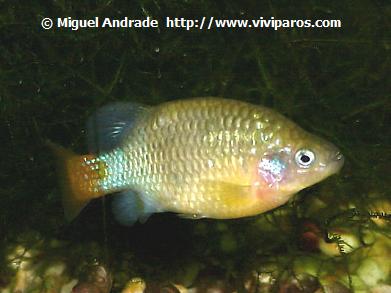
Xenotoca eisei male. |
1. Temperature :
In contrast to the heated tank for tropical fish, in which a constant
temperature is maintained by the means of an adjustable heater, a tank
for Goodeids does not require heating. Depending on where the aquarium
is set up, the temperature varies during the course of the year but
remains within a range set by rather low winter temperatures and higher
ones in the summer. Variation according to the time of day might be
achievable but this is not necessary.
The temperature range, which depends on the place the aquarium is set
up, should determine which species are kept.
If this range differs too much from what the maintained fish need, the
aquarist is likely to become dissatisfied. Although Goodeids can
tolerate low temperatures quite well in general, as a result many
species become inert and retract. In unfavourable cases one may see
relatively little activity for half a year.
Temperatures that are too high are even worse, since they harm the fish.
The critical upper limit may differ substantially from one species to
another, and it can be raised a few degrees Celsius / Fahrenheit by
means of good aeration. Indicators of too warm maintenance are fish
beginning with, intensified respiration frequency followed by increased
susceptibility to disease, quickly leading to the first losses.
Here, a warning is left to all those who are toying with the idea of
keeping, for example, one of the Girardinichthys species in a flat.
These species can be kept in a cool, unheated stairwell, but the ideal
place for them is in the cellar.
If you live in a region with hot summers or in a big city and if you
like your home warm during the winter the following genera can be
recommended, since they tolerate heat : Ameca, Ataeniobius,
Chapalichthys ( C. pardalis ), Ilyodon,
Xenotaenia, Xenotoca ( X. eiseni ). |
|
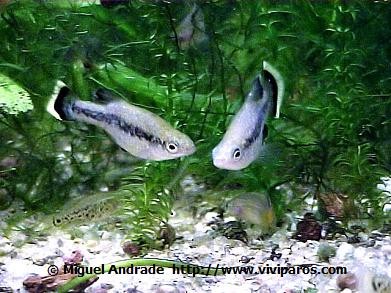
Ameca splendens
young males disputing.
Large species like this
must be accommodated in large aquariums at least 120 centimetres / 45
inches long. |
The following genera can
cope with summer heat relatively well, but as compensation they need an
annual period with cooler temperatures, of about 20ºC / 68ºF during the
winter : Allodontichthys, Characodon, Chapalichthys
( C. encaustus ), Xenoophorus, Xenotoca ( X.
melanosoma & X. variata ), Zoogoneticus.
In aquaria that are set up in cooler rooms like bedrooms or guestrooms
where the temperature does not rise above 25ºC / 77ºF, the following
genera can be recommended : Alloophorus, Allotoca, Goodea, Skiffia.
Girardinichthys and Hubbsina require a maintenance temperature below
20ºC / 68ºF and should, as mentioned, ideally be kept in a cellar.
2. Technical equipment : as already indicated, strong aeration
via air-stone is beneficial for Goodeids and may even be vital during
the summer if a large group of fish is kept in one tank. The most
important thing about the filter-system used is that it works reliably.
I would recommend manufacturers that guarantee the future availability
of spare-parts for their products like ceramic shafts of membranes. This
is an indication of quality, and taking into account the many years such
equipment is in use, it is usually cheaper than the “ special offers “
that are advertised.
For artificial illumination of the tank, all high colour rendition
neon-lights are well suited that have a value of 800, according to the
Philips numeric colour codes. Under the light of these fluorescent lamps
the colours of the fish and the tank decoration appear natural,
water-plants grow well and, moreover, these neon-lights are inexpensive.
Warm or cool white, indicated as 830 or 840, are quite common and easily
available, and other colours may be available from specialized dealers.
For the illumination of silvery fish bluish daylight ( 880 ) is
appropriate with its colour temperature of 8000 Kelvin, whereas in the
case of C. lateralis illumination with warm white ( 827, 2700 Kelvin )
makes the fish look very attractive.
I do not find the rather expensive “ natural sunshine “ fluorescent
lights, code 900 according to the Philips numeric color codes,
convincing me since they are not bright enough, having just one lamp on
top of each tank. |
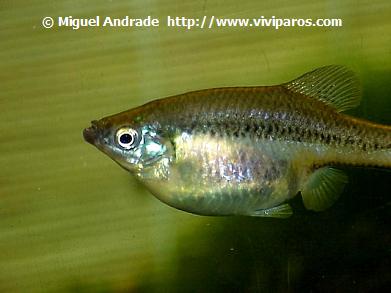
Skiffia multipunctatta
expectant female. |
3. Water : For
the maintenance and breeding of Goodeids ordinary tap water is suitable
as long as it meets the standards of drinking-water. Special treatment
is not necessary except that it can be advisable to use temperate water
when changing large quantities in the winter, because otherwise the
water in the aquarium might become too cold.
Whether the water is hard or soft does not play a major role, although
one should avoid roots and leaves for decoration, at least in soft water
since they may give off substances that can acidify the water and create
a milieu that is unfavourable for Goodeids.
Stones are best used for decoration, and it does not even matter if they
harden the water, which may be the case with limestone, for instance.
Regular partial water change is good for the fish. I change about a
third of the aquarium water every fortnight, and during the summer I
exchange the same amount weekly. The amount of exchanged should
correspond to the number and size of the fish in the tank.
Cold tap water can normally be used for the exchange, but it is
important that, as mentioned above, the temperature does not fall too
much, especially in the winter. 15ºC / 59ºF is an approximate lowest
temperature for most species, especially if there is fry in the tank.
4. Tank decoration and socializing with other fish : proper
Goodeid maintenance for me starts with tanks which are at least 80
centimetres / 30 inches long. In such tanks many of the smaller species
can be successfully kept and bred.
Large species like Ameca, Ilyodon or Goodea must be
accommodated in large aquariums at least 120 centimetres / 45 inches
long, because otherwise they are unlikely to reach their full size or
show much of their typical behaviour.
Attempts to socialize Goodeids with elephant fish, blowfish or Malawi
Cichlids show a lack of aquaristic sensitivity and should be avoided. |
|
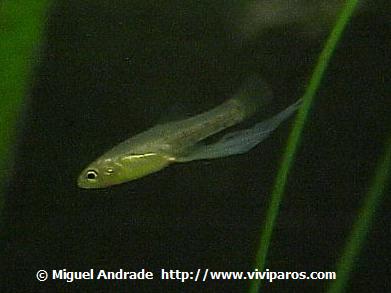
Ameca splendens
new born with trophotenia still visible. |
Of course, it is
possible to keep Goodeids successfully along with other fish in a
community tank. Indeed, many aquarists have done so, and this will
certainly provide a rich field for aquaristic activity in the future.
The concern of this article, however, is to exclude any factors of
maintenance which may lead to failure, and that is why I recommend
beginning with one species per tank. I have always kept my Goodeids in
species tanks only and find this entirely satisfactory.
For the establishment of a colony young fish are much better than
adults. One should start with a group of at least 10 specimens and more
is even better. This will quickly lead to a prospering colony and make
it possible to pass on fry to other aquarists after a while.
Young fish are also usually less likely to panic than adults transferred
to a new environment. After being transported Goodeids frequently stay
timid for a couple of weeks. When panicking, they dart around the
aquarium, often colliding heftily with its decoration or the glass.
Here, lot sensitivity on part of the aquarist is required. Shelter
should be provided for the fish in the form of plants or stone
structures. Moreover, a cover of floating plants such as sponge plant
calms the fish down.
At first, an aquarium with timid fish should be approached very
cautiously and slowly. If you have the time, you can make yourself
comfortable at a little distance from the tank for a while and watch the
fish emerging from their shelter and slowly becoming more confident.
After a while some of the plants can be removed, leaving a small dense
group in one back corner of the tank into which the fish can withdraw.
The rest may be left bare except for some stone superstructures.
After a while the fish will be seen swimming in the open water more
often. Many Goodeids will become so tame that they can be fed from the
hand. Once the fish have lost their fear, the aquarium can gradually be
redecorated to suit one’s taste and more plants can be introduced.
Water-plants which are well suited are described in the article “ Plants
for the Goodeid tank ”.
5. Feeding : For a long time I have exclusively fed my Goodeids
on flake-food, which I mix with crushed Gammarus.
|
|
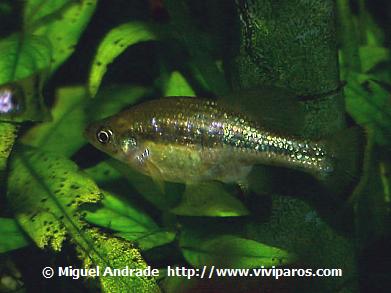
Ameca splendens
adult male showing the traditional light reflexes on
some scales. |
The only exception to
this routine is the treatment of their fry, which are given hatched
brine-shrimps in addition until they reach a size of about 4
centimetres. Gammarus are easily available as turtle-food, and
mixing 70% ( by volume, not weight ) of flake-food with 30% of crushed
Gammarus has proved a good proportion.
Once it is open, I try to finish a package of food within a month. When
a package is finished I take a different brand to provide some change,
but I stick to the products of well-known manufacturers. Usually I feed
once a day using feeding rings, although twice a day would be certainly
better.
In my experience a high-protein diet or contaminated food often causes
intestinal infections in Goodeids.
Gammarus, on the other hand, contains a lot of fibre and since it
has been dried, some of it keeps afloat for a couple of hours in the
feeding ring, serving as a supply. Food consumption can vary
significantly between different species, but also with the water
temperature.
In comparison with other fish Goodeids have a comparatively strong
metabolism and I usually give them more food than they can finish within
a couple of minutes. The leftovers are taken care of by the snails and
freshwater shrimps that live in great numbers in my aquaria.
Every fortnight my Goodeids are not fed for one day and I also try to
reduce the daily portion from time to time in order to provide some
change to the everyday routine and to provoke a slight hunger in my
fish, keeping them active and healthy. If there are water plants or
algae in the aquarium, there is absolutely no need to feed scalded
spinach, lettuce and the like, as often recommended. The green droppings
of the fish prove that there is enough plant food for them in such
aquaria.
As described, nutrition that meets the needs of Goodeids can very easily
be provided in a daily routine. Nevertheless, I will now briefly
consider alternatives and report my personal experience : |
|
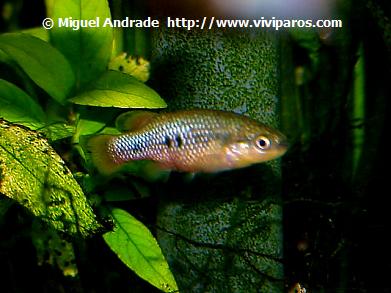
Characodon lateralis
adult male. |
1. Live food - If you have access to sources providing
you with clean live-food, this will certainly be an advantageous extra for
your Goodeids. Be warned though that a few species like Ameca spelendens
and Xenotoca eiseni might start fin-nipping after being fed with live
Daphnia, for instance. This may sound strange, but I have not only
heard other aquarists reporting this but have experienced it myself.
Feeding frozen live food always has disadvantages in my experience, so I now
refrain from using it altogether. Attempts to hatch various sorts of
insects, larvae, Daphnia, Moina as live food at home have
never been a success, neither in respect of quality nor in respect of
quantity. The only thing I can really recommend here is hatching brine
shrimps, whose nauplii are excellent food for raising fry. Here large
quantities associated with consistent quality are easy to produce and the
procedure does not take up a lot of space.
2. DIY: After experimenting and also reading a lot about the topic myself, I
think it unlikely that the amateur can produce food that is in any way
superior to the food offered commercially for ornamental fish.
The Goodeids being and bred in the Fish-Ark maintenance programme at the
University of Morelia are exclusively fed flake food, live Daphnia
and Artemia.
This is not the only way to do thing, of course, and there are certainly
fellow hobbyists who use other methods and successfully keep and breed their
Goodeids. In writing this article, my main concern has been to avoid all
those factors which might cause problems and to explain how any interested
aquarist can keep and breed the vast majority of these attractive fish.
Matthias Naumann
|
